Finasteride Before and After
We offer a clear look at finasteride’s ability to regrow hair in this collection of before and after photos.

Finasteride is a prescription hair loss treatment that multiple studies show has the ability to stop hair loss and regrow hair for some men.1 But results don’t come overnight, so knowing what to expect and when to expect it can help keep you on the right track.
That’s why we’ve collected these examples of hair loss patients who have had success with oral finasteride, sometimes known by the brand name Propecia. These images will give you a rough idea of what your hair recovery journey might look like at different points in the process.
Bear in mind that no two patients have identical experiences. You may find that your hair grows back more or less quickly than the men in these examples. But, statistically, you will most likely find that it will grow back.2 Any hair follicles that have gone dormant but have not yet died will almost certainly revive themselves in the presence of finasteride.
What to look for in finasteride photos
Studies indicate that finasteride’s greatest strength is reinvigorating the hairline, but it can also produce hair regrowth at the crown and vertex of the head.4 Some examples will clearly show its ability to reclaim scalp lost to a receding hairline. Here’s a great example of a hairline that’s begun to grow back toward the front of the scalp:

And while finasteride doesn’t have the same stellar track record at the vertex and crown as minoxidil, studies and plenty of examples attest to the fact that it can provide some benefit there, as well.5 6
Notice in the image below how much fuller the hair has become after using finasteride for two years:
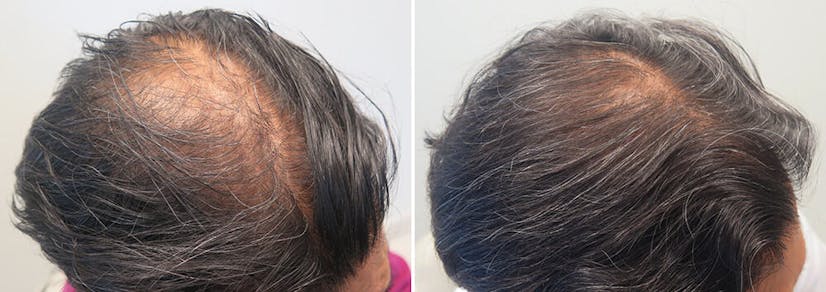
Photos before and after less than a year
While it takes the better part of a year for finasteride’s effects to be in full swing, the medication starts working quickly to curb your hair loss.1 You’ll likely start seeing some results after 3-4 months. Here’s a look at some patients who saw relatively fast results using finasteride between 4 and 6 months.


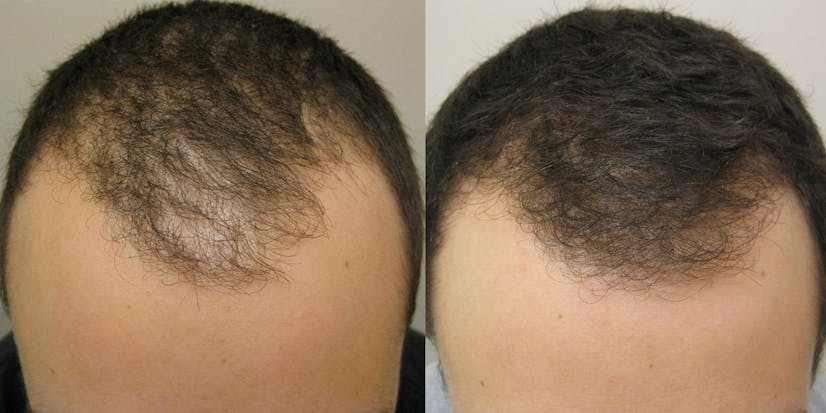

Our bottom line recommendations for finasteride
You may already be interested in trying finasteride, so here’s our breakdown of recommendations. Finasteride was originally prescribed to treat hair loss in an oral form, but a topical solution is now an alternative option for many men. (Below, we’ll show you more before-and-after pictures, including those specific to the topical approach.) Depending on the course of treatment you’re most interested in, you might do better with one hair loss treatment company or another.
- For a traditional combination of oral finasteride and topical minoxidil, a long-term approach of mixing the services of Keeps (for minoxidil) and Roman (for finasteride) will ensure the lowest price while still providing you access to the sprawling telehealth infrastructure Roman offers. For men who want to keep it more convenient and get both treatments from a single provider, Keeps is our recommendation. (You can also get 50% off your first three months of treatment there, which is a great way to save money while trying it out.)
- For oral finasteride alone, we recommend Roman. Its prices are the lowest over the long haul (you have to keep taking finasteride for it to keep working), and having access to other medications like sildenafil (generic for Viagra) could come in handy if you experience any of the sexual side effects associated with oral finasteride.3
- For topical finasteride, we typically recommend Hims, which offers biannual and quarterly billing options that bring its price down lower than direct competitors. Keep in mind that topical finasteride is rarely compounded without including minoxidil. Hims offers a 6% minoxidil, 0.3% finasteride spray, whereas Keeps’ topical finasteride is a 5% minoxidil, 0.25% finasteride solution.
Photos before and after one year
Any hair loss treatment takes time. Most finasteride users will notice a cessation of hair loss within the first 1-3 months, followed by a protracted period of regrowth that can take a year or more to recover any available hair follicles.2 Variables like genetics and the degree of hair loss at the time of treatment will all play a part.
Here’s a series of before and after photographs that reflect the progress many men make after one year of daily finasteride administration.
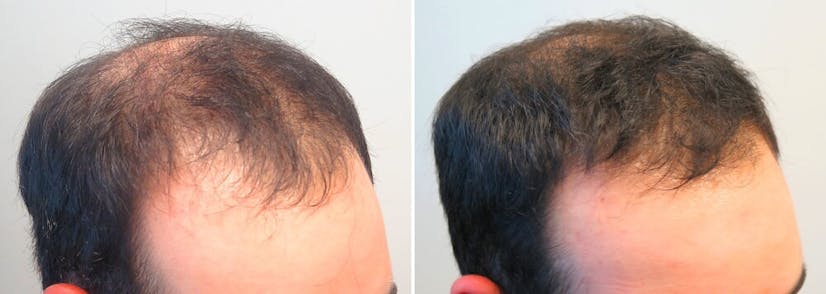
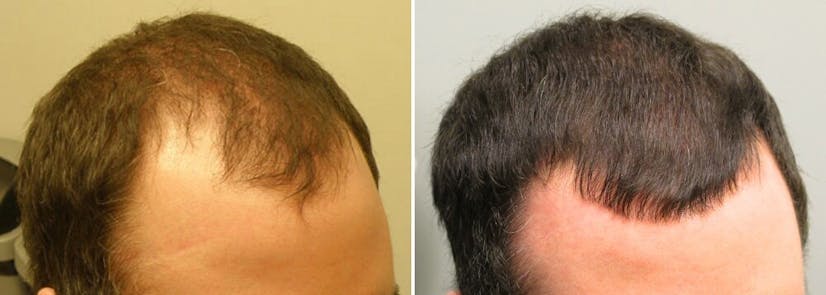



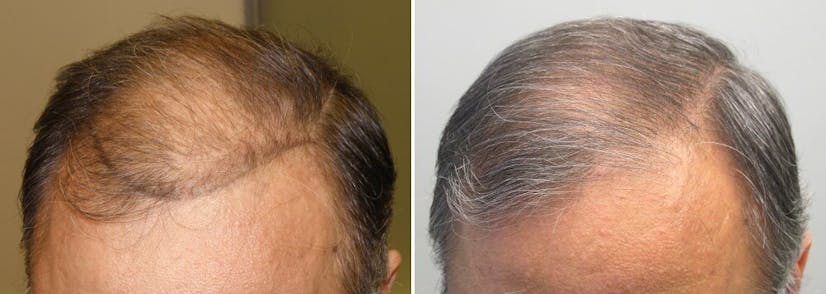




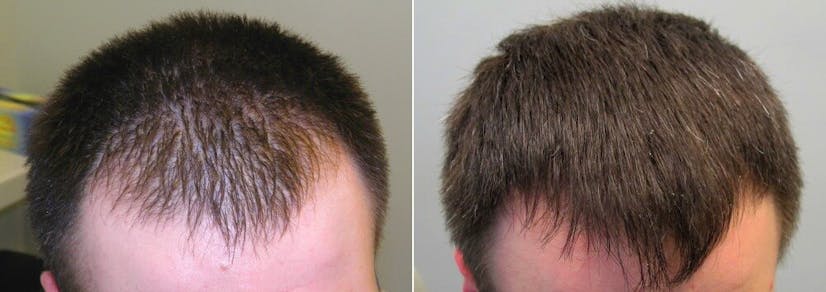


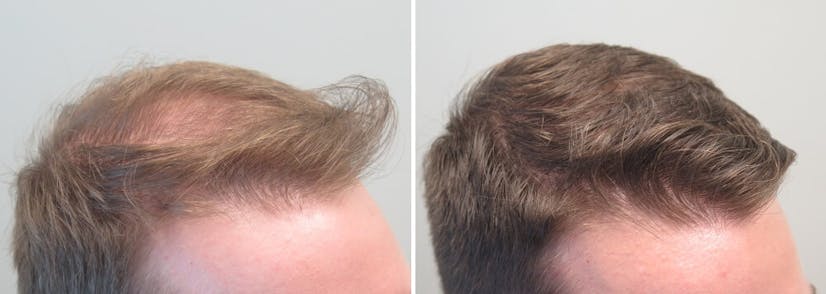
Long-term finasteride before and after photos
For finasteride to work, you have to keep taking it. As soon as you stop, your hair loss will begin anew.1 The good news is that many men continue to regrow their hair more than a year after starting their finasteride regimen, at least according to these images.
Here’s a look at some long-term successes in men who have taken finasteride for more than one year.
After 16 months




After two or more years



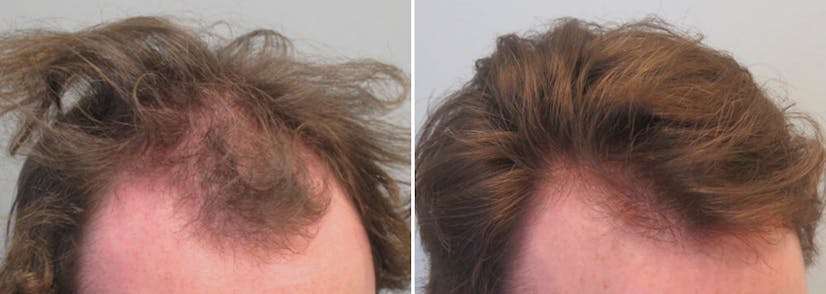
Topical finasteride: before and after photos
While most people consume finasteride in its pill form, a topical form of finasteride is also available. It’s a good alternative to oral finasteride for those concerned with potential sexual side effects, as it inhibits scalp DHT effectively without having a significant effect on serum DHT.7
For now, here are some images that illustrate topical finasteride’s potential after only 4-6 months of use:









Finasteride combined with minoxidil
Studies into the efficacy of a combined approach — putting finasteride and topical minoxidil (Rogaine) together — show impressive results.8 It seems that the drugs work well together, with no contraindications and significantly improved outcomes.
Here are some before and after photos of finasteride and minoxidil combined, showing how well they can work together. Some of these images represent minoxidil combined with topical finasteride, while others represent minoxidil combined with oral finasteride.
Before and after: one year or less





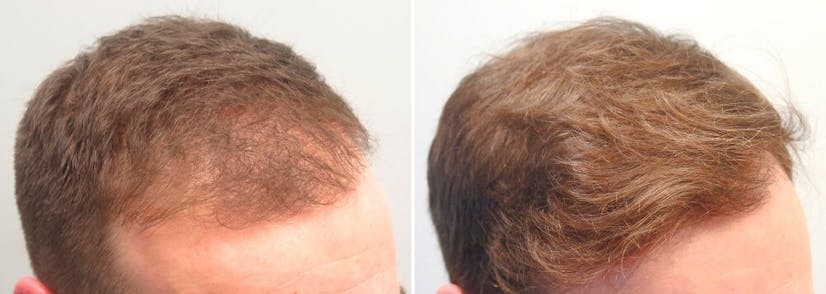



After more than one year








How does finasteride work?
Finasteride belongs to a class of drugs called 5-alpha reductase inhibitors, which act to minimize the conversion of testosterone into dihydrotestosterone (DHT).9 DHT, especially on the scalp, is the primary culprit in androgenetic alopecia, or pattern hair loss.10 For this reason, finasteride might not be a viable solution for hair loss caused by other issues, such as nutritional deficiencies or chemotherapy and radiation.
Is finasteride safe?
While finasteride should be safe for the majority of people who take it, there are small percentages that encounter unpleasant sexual or depressive side effects, including a drop in libido, erectile dysfunction, and even infertility. Studies indicate that these side effects only affect 2-3% of finasteride users at the dose prescribed to treat hair loss, which is 1mg. Sexual side effects are more common at higher doses typically prescribed to treat benign prostatic hyperplasia.3
Topical finasteride may be a better choice for men looking to reap the benefits of the drug with fewer of its side effects. But topical finasteride is typically compounded in a minoxidil solution, so you may experience some of the side effects associated with topical minoxidil, including itching, burning, or scaling of the scalp.
Alternatives to finasteride
Finasteride is not the only option men have to stop hair loss and regrow their hair. And for 2-3% of users, it may cause potentially serious sexual side effects.3 Minoxidil, nanoxidil, laser caps, botanicals like saw palmetto, and hair restoration surgery are just a few of the viable therapies on the market.
If you’re curious about finasteride or its viable alternatives, be sure to read our comprehensive guide to the best hair loss treatments available.
Final takeaway
Finasteride has been on the market for decades, and both clinical research and anecdotal reports from users confirm that it has tremendous potential to stop hair loss and, in many cases, to regrow some lost hair. There are other effective options on the market that may be better choices for men concerned with potential sexual or depressive side effects. But the vast majority of men don’t experience those side effects, and if you try finasteride and don’t experience them, you’ll have found a reliable, safe, and inexpensive way to treat your hair loss.
Sources
Innerbody uses only high-quality sources, including peer-reviewed studies, to support the facts within our articles. Read our editorial process to learn more about how we fact-check and keep our content accurate, reliable, and trustworthy.
Kaufman, K. D., Olsen, E. A., Whiting, D., Savin, R., DeVillez, R., Bergfeld, W., Price, V. H., Van Neste, D., Roberts, J. L., Hordinsky, M., Shapiro, J., Binkowitz, B., & Gormley, G. J. (1998). Finasteride in the treatment of men with androgenetic alopecia. Finasteride Male Pattern Hair Loss Study Group. Journal of the American Academy of Dermatology, 39(4 Pt 1), 578–589.
Libecco, J. F., & Bergfeld, W. F. (2004). Finasteride in the treatment of alopecia. Expert Opinion on Pharmacotherapy, 5(4), 933–940.
Mysore, V. (2012). Finasteride and sexual side effects. Indian Dermatology Online Journal, 3(1), 62-65.
Leyden, J., Dunlap, F., Miller, B., Winters, P., Lebwohl, M., Hecker, D., Kraus, S., Baldwin, H., Shalita, A., Draelos, Z., Markou, M., Thiboutot, D., Rapaport, M., Kang, S., Kelly, T., Pariser, D., Webster, G., Hordinsky, M., Rietschel, R., Katz, H. I., … Waldstreicher, J. (1999). Finasteride in the treatment of men with frontal male pattern hair loss. Journal of the American Academy of Dermatology, 40(6 Pt 1), 930–937.
Rietschel, R. L., & Duncan, S. H. (1987). Safety and efficacy of topical minoxidil in the management of androgenetic alopecia. Journal of the American Academy of Dermatology, 16(3 Pt 2), 677–685.
Shapiro, J., & Kaufman, K. D. (2003). Use of Finasteride in the Treatment of Men With Androgenetic Alopecia (Male Pattern Hair Loss). Journal of Investigative Dermatology Symposium Proceedings, 8(1), 20-23.
Piraccini, B. M., Scarci, F., Jansat, J. M., Falqués, M., Otero, R., Tamarit, M. L., Galván, J., Tebbs, V., Massana, E., & Study Group, T. F. (2022). Efficacy and safety of topical finasteride spray solution for male androgenetic alopecia: A phase III, randomized, controlled clinical trial. Journal of the European Academy of Dermatology and Venereology, 36(2), 286-294.
Hu, R., Xu, F., Sheng, Y., Qi, S., Han, Y., Miao, Y., Rui, W., & Yang, Q. (2015). Combined treatment with oral finasteride and topical minoxidil in male androgenetic alopecia: a randomized and comparative study in Chinese patients. Dermatologic Therapy, 28(5), 303–308.
Salisbury, B.H., Tadi, P. (2023, April 4). 5-Alpha-Reductase Inhibitors. StatPearls [Internet]. Treasure Island (FL): StatPearls Publishing.
Kinter, K.J., Anekar, A.A. (2023, January). Biochemistry, Dihydrotestosterone. StatPearls [Internet]. Treasure Island (FL): StatPearls Publishing.







